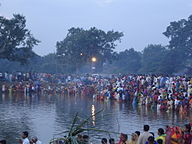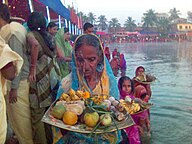Chhath: Difference between revisions
Abhisuroon (talk | contribs) No edit summary |
Mkg just4u (talk | contribs) No edit summary |
||
| Line 1: | Line 1: | ||
{{Use dmy dates|date=March 2013}} |
{{Use dmy dates|date=March 2013}} |
||
{{Infobox holiday | |
{{Infobox holiday | |
||
|holiday_name = Chhath |
|holiday_name = Chhath |
||
|type = Hindu |
|type = Hindu |
||
| ⚫ | |||
| ⚫ | |||
|imagesize = |
|||
| ⚫ | |||
|caption = Performing of morning [[Puja (Hinduism)|puja]] to [[Surya]] in Janakpur, Nepal. |
|caption = Performing of morning [[Puja (Hinduism)|puja]] to [[Surya]] in Janakpur, Nepal. |
||
|official_name = |
|||
|nickname = Chhathi<br>Dala Chhath<br>Surya Shashthi |
|nickname = Chhathi<br>Dala Chhath<br>Surya Shashthi |
||
|observedby = Hindu and Jain |
|observedby = Hindu and Jain |
||
| ⚫ | |||
|litcolor = |
|||
| ⚫ | |||
| ⚫ | |||
| ⚫ | |||
| ⚫ | |||
| ⚫ | |||
| |
|begins = 2 days prior to Kartik Shashthi |
||
| ⚫ | |||
| ⚫ | |||
| ⚫ | |||
|scheduling = |
|||
|duration = |
|||
|frequency = |
|||
|date2012 = |
|||
| ⚫ | |||
|date2014 = |
|||
|date2015 = |
|||
|celebrations = |
|||
| ⚫ | |||
|relatedto = |
|||
}} |
}} |
||
Revision as of 22:43, 7 November 2013
| Chhath | |
|---|---|
 | |
| Also called | Chhathi Dala Chhath Surya Shashthi |
| Observed by | Hindu and Jain |
| Type | Cultural, Historical, Religious |
| Significance | To thank Surya for bestowing the bounties of life on earth and fulfilling particular wishes |
| Observances | Prayers and religious rituals, including puja and prasad, bathing in the Ganges, and fasting |
| Begins | 2 days prior to Kartik Shashthi |
| Ends | The day after Kartik Shashthi |
| Date | Kartik Shukla Shashthi |
| 2024 date | |
Chhath (Devanagari: छठ, छठी, छठ पर्व, छठ पुजा, डाला छठ, डाला पुजा, सुर्य षष्ठी) is an ancient Hindu festival and only Vedic Festival dedicated to the Hindu Sun God, Surya.[2] The Chhath Puja is performed in order to thank Surya for sustaining life on earth and to request the granting of certain wishes.[3]
The Sun, considered the god of energy and of the life-force, is worshiped during the Chhath festival to promote well-being, prosperity and progress. In Hinduism, Sun worship is believed to help cure a variety of diseases, including leprosy, and helps ensure the longevity and prosperity of family members, friends, and elders.
The rituals of the festival are rigorous and are observed over a period of four days. They include holy bathing, fasting and abstaining from drinking water (Vratta), standing in water for long periods of time, and offering prashad (prayer offerings) and arghya to the setting and rising sun.
Although it is observed most elaborately in Bihar, Jharkhand, Eastern UP and the Terai regions of Nepal in modern times, and is more prevalent in areas where migrants from those areas have a presence, it is celebrated in all regions and major urban centers in India. The festival is celebrated in the regions including but not exclusive to the northeast region of India, Madhya Pradesh, Uttar Pradesh, Chhattisgarh, Chandigarh, Gujarat,[4] Delhi,[5] Mumbai[6] Mauritius, Fiji, Trinidad and Tobago, Guyana, Suriname, and Jamaica. .[7]
Date of the festival
Chhath puja is performed on Kartika Shukla Shashthi, which is the sixth day of the month of Kartika in the Hindu Calendar. This falls typically in the month of October or November in the Gregorian Calendar.
It is also celebrated in the summer (March–April), on Chaitra Shashthi, some days after Holi; this event is called Chaiti Chhath.[8] The former is more popular because winter is the usual festive season in North India, and Chhath, being an arduous observance, requiring the worshipers to fast without water for around 36 hours continuously, is easier to undertake in the Indian winters.
Etymology
The word chhath denotes the number six in Hindi[9] and the festival is celebrated on the sixth day of the Hindu lunar month of Kārtika. The word is a Prakrit derivation from the Sanskrit ṣaṣṭhi, meaning sixth.
History
It is believed that the Maga Purohits (modern days known as Shakya Dwipi Brahmins) were invited by local kings for their expertise in Sun worshiping. They started the tradition of Chhat Puja.
It is believed that the ritual of Chhath puja may even predate the ancient Vedas texts, as the Rigveda contains hymns worshiping the Sun god and describes similar rituals. The rituals also find reference in the Sanskrit epic poem Mahābhārata in which Draupadi is depicted as observing similar rites.
In the poem, Draupadi and the Pandavas, rulers of Hastinapur (modern Delhi), performed the Chhath ritual on the advice of noble sage Dhaumya. Through her worship of the Sun God, Draupadi was not only able to solve her immediate problems, but also helped the Pandavas later regain their lost kingdom.
It is also believed that Chhath was started by Karna, the son of Surya (Surya Putra Karna). Surya Putra Karna ruled over the Anga Desh (present day Bhagalpur district of Bihar) during the Mahabharat Age. He was a great warrior and fought against the Pandavas in the Kurukshetra War.
Its yogic/scientific history dates back to the Vedic times. The rishis of yore used this method to remain without any external intake of food as they were able to obtain energy directly from the sun's rays. This was done through the Chhath method.[10]
Chhathi Maiya
It is also said that the Goddess that is worshipped during the famous Chhath Puja is known as Chhathi Maiya. Chhathi Maiya is known as Usha in the Vedas. She is believed to be the consort of Surya, the sun god. Some scholars are of the view that she is only the beloved of Surya and some suggest that she is Surya’s wife.
Usha is the term used to refer to dawn – The first light of day. But in the Rig Veda she has more symbolic meaning. Symbolically Usha is the dawn of divine consciousness in the individual aspirant. It is said - Usha and Pratyusha, wives of Sun are the main source of Sun. Both Usha and Pratyusha are worshiped along with Sun in chhath parva. Usha (literally-the first morning sun-ray) is worshipped on the last day and Pratyusha(the last sun-ray of day) is worshipped in the evening by offering water or milk to the rising and setting sun respectively.
During the Chhath Puja, Chhathi Maiya is invoked to bless us with this divine consciousness which will help us to overcome all the troubles in the world – this bless will help us to Moksha or liberation.
Rituals and traditions
Chhath is a festival of bathing and worshipping,that follows a period of abstinence and segregation of the worshiper from the main household for four days. During this period, the worshiper observes purity, and sleeps on the floor on a single blanket.This is the only holy festival which has no involvement of any pandit (priest).The devotees offer their prayers to the setting sun, and then the rising sun in celebrating its glory as the cycle of birth starts with death. It is seen as the most glorious form of Sun worship.
Nahay khay
On the first day of Chhath Puja, the devotees take a dip, preferably in the river Ganga and carry home the holy water of Ganga to prepare the offerings. The house and surroundings are scrupulously cleaned. The ladies observing the Vrata called vratin allow themselves only one meal on this day.
Lohanda and Kharna
On the second day of Chhath Puja, the day before Chhath, the Vratins observe a fast for the whole day, which ends in the evening a little after sunset. Just after the worship of Sun and moon , the offerings of Rasiao-kheer (rice delicacy), puris (deep-fried puffs of wheat flour) and bananas, are distributed among family and friends. The Vratins go on a fast without water for 36 hours after 2nd day evening prashad(kheer).
Sandhya Arghya (evening offerings)
This day is spent preparing the prasad (offerings)at home. On the eve of this day, the entire household accompanies the Vratins to a riverbank, pond or a common large water body to make the offerings (Arghya) to the setting sun. It is during this phase of Chhath Puja that the devotees offer prayers to the just setting sun. The occasion is almost a carnival. Besides the Vratins, there are friends and family, and numerous participants and onlookers, all willing to help and receive the blessings of the worshipper. The folk songs sung on the evening of Chhath.
Usha Arghya (morning offerings)
On the final day of Chhath Puja, the devotees, along with family and friends, go to the riverbank before sunrise, in order to make the offerings (Arghya) to the rising sun. The festival ends with the breaking of the fast by the Vratins. Friends, Relatives visit the houses of the devotees to receive the prashad.
The main worshipers, called Parvaitin (from Sanskrit parv, meaning 'occasion' or 'festival'), are usually women. However, a large number of men also observe this festival. The parvaitin pray for the well-being of their family, and for the prosperity of their offsprings. Once a family starts performing Chhatt Puja, it is their duty to perform it every year and to pass it on to the following generations. The festival is skipped only if there happens to be a death in the family that year.
The prasad offerings include sweets, Kheer, Thekua and fruit offered in small bamboo soop winnows. The food is strictly vegetarian and it is cooked without salt, onions or garlic. Emphasis is put on maintaining the purity of the food.[11]
Pictures of Chhath
- Chhath Puja
-
Morning worship at Jamshedpur, Jharkhand
-
On the second day of Chhat devotees pay tribute to the rising Sun
-
View of a ghat in a village near Muzaffarpur, Bihar
References
Chhath Puja Festival & Celebrations
- ^ http://chhathpuja.org/
- ^ Festivals of India - CHHATH FESTIVAL
- ^ "Destinations :: Patna".
- ^ "Surat 1 lakh to celebrate chhath puja". Jai Bihar. 22 October 2009. Retrieved 14 December 2009. [dead link]
- ^ "15 lakh to observe Chhath Puja in Delhi". Jai Bihar. 22 October 2009. Retrieved 14 December 2009. [dead link]
- ^ "Juhu Beach decks up for worshiping the sun god". DNA India. 24 October 2009. Retrieved 14 December 2009.
- ^ "Festive fervour reaches Fiji, Mauritius, Trinidad, Guyana, and Suriname". The Telegraph – Calcutta(Kolkata). 24 October 2009. Retrieved 14 December 2009.
- ^ "Chaiti Chhath to start today". Jai Bihar. 30 March 2009. Retrieved 14 December 2009. [dead link]
- ^ Etymology of India
- ^ Sri Chhath Mahaviggyaan (The Science of Chhath) by Yogishri Oumkaar
- ^ "'Rasiao-kheer', 'thekua' make for festive platter". The Times of India. 1 November 2011. Retrieved 13 March 2012.







